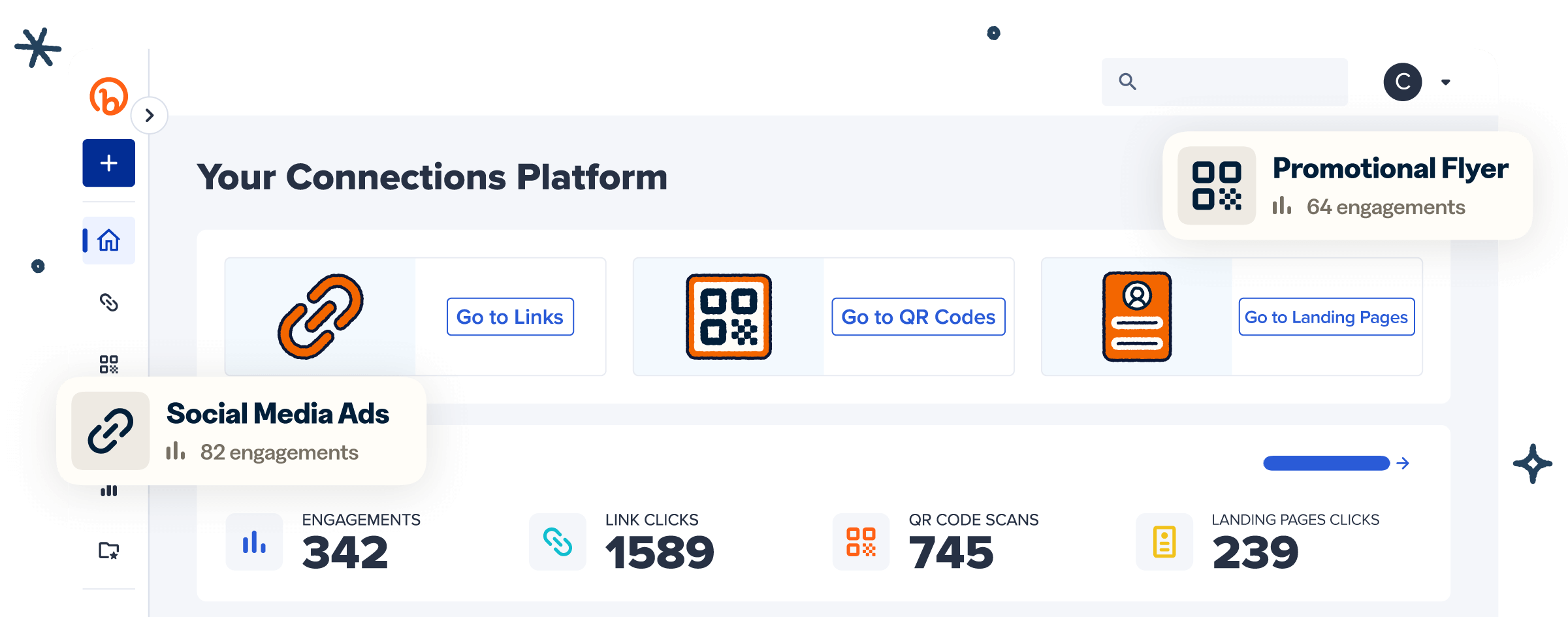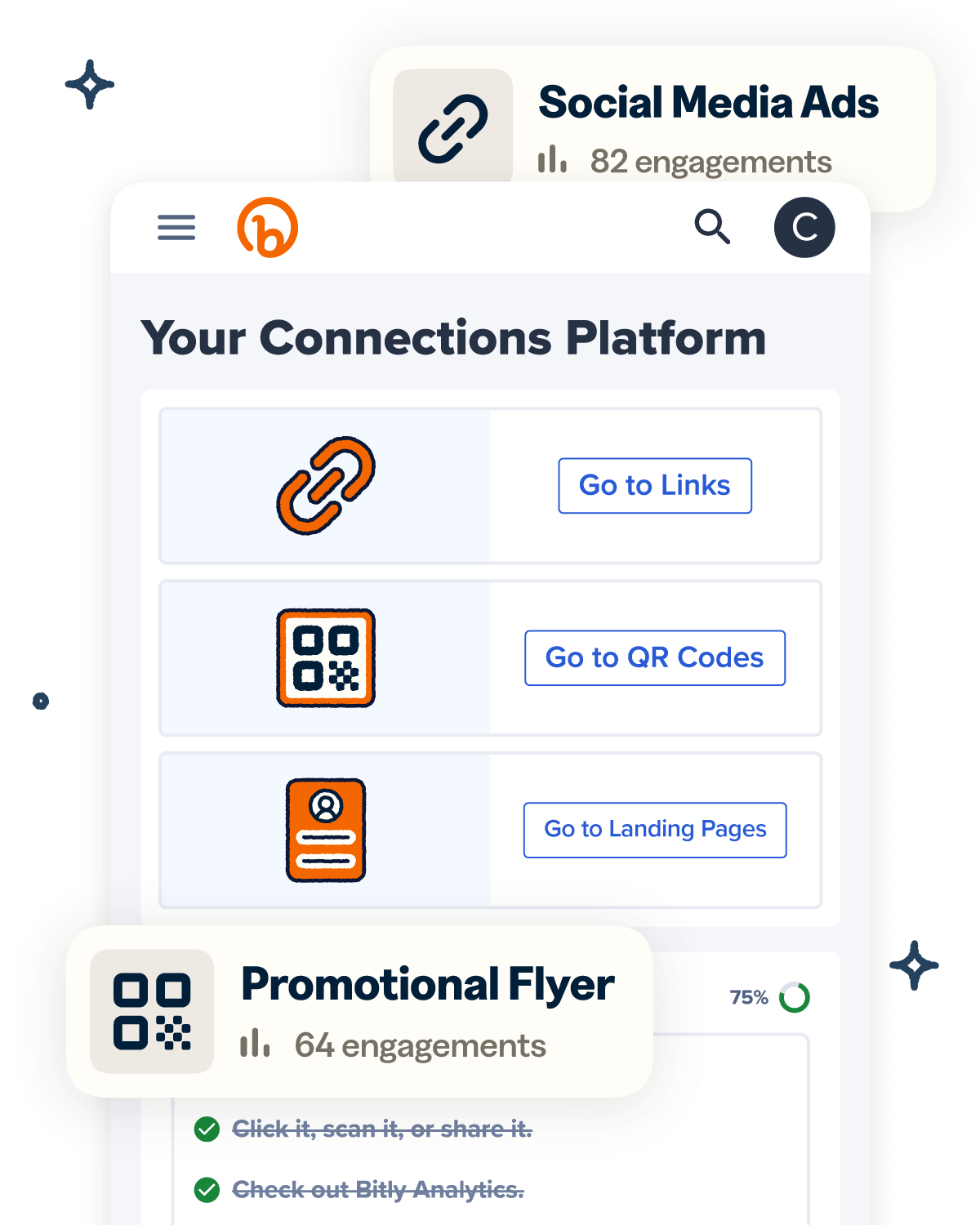Pre-event marketing is usually a top priority for businesses planning conferences, shows, forums, and webinars. After all, everyone wants to attract as many people as possible to their event.
However, while undoubtedly important, the event itself shouldn’t be your only focus. Post-event engagement is just as crucial, if not more so, as it can determine whether your brand remains front and center in your target audience’s minds. If well-implemented, it can help maintain momentum from your event, nurture leads, and drive long-term brand relationships.
In this post, we look at why post-event engagement matters. We also explore how to use QR Codes, short links, email marketing, and social media to keep attendees engaged and measure your post-event engagement success.
Note: The brands and examples discussed below were found during our online research for this article.
Why post-event engagement matters
Post-event engagement, whether through feedback QR Codes, Q&A sessions on social media, or short links in email campaigns that provide exclusive content, can make all the difference in achieving your event goals.
Effective engagement can positively impact retention, event ROI, and future event success by keeping your brand in attendees’ minds and providing valuable customer data. Here’s an in-depth look at why it’s a worthwhile investment.
Turning attendees into long-term brand advocates
With an average customer acquisition cost (CAC) of $1,143 in education, $723 in manufacturing, and $239 in B2B SaaS, you can’t afford to drop the ball in customer retention efforts.
An event is a great way to promote loyalty, as it allows you to connect directly with attendees. But it becomes much more effective if you follow up with post-event engagement.
Post-event follow-ups help keep the emotional connection between attendees and your brand alive and encourage ongoing participation in company activities, such as future events or sales. Over time, this can transform attendees into active customers and brand advocates who share their experiences and recommend your brand to others, lowering future acquisition costs.
Maximizing the return on investment (ROI) from events
The success of an event isn’t just measured by attendance but by how attendees interact with your brand afterward. If you have many positive interactions—attendees purchasing products, signing up for services, getting on your email list—then you can consider your event a success.
To make this a reality, you need to invest in post-event engagement. It helps you maximize the ROI from events by maintaining momentum and keeping attendees on course in their conversion journeys.
For example, if an event sparks interest in your offerings, a simple post-event engagement tactic like sending thank-you messages can help build emotional connections with attendees. This keeps your brand top-of-mind and makes them more likely to purchase your product when a need arises.
Tracking and optimizing interactions
Engaging with attendees provides valuable data to refine both future events and post-event follow-ups. By sending attendees surveys after the event, you can determine what left a positive impression and what didn’t, allowing you to improve future events. And, optimizing future events based on attendee input can result in up to 20% more satisfaction.
Using trackable solutions like QR Codes and short links in your post-event engagement provides even more valuable insights for future campaign optimization. They can show you which post-event follow-ups generate the most scans or clicks, allowing you to make well-informed decisions for future campaigns.
Examples of post-event email marketing strategies
With an average open rate of 21.33%, email can be a powerful tool for engaging attendees and driving further interaction. It can also provide valuable insights into what resonates with your audience through metrics like total link engagements and click-through rates. These post-event email marketing strategies are a great place to start.
Sending personalized thank-you emails
While it may seem like a small gesture, appreciating attendees for taking time out of their schedules to attend your event can go a long way in nurturing them and encouraging them to convert. Personalized thank-you emails demonstrate professionalism and make attendees feel valued, which can help strengthen their relationship with your brand.
For optimal results, send thank-you emails 24 to 48 hours after your event, when it’s still fresh in attendees’ minds. Be sure to highlight some exciting things that happened during your event, and if possible, include a personal detail about each attendee. At a minimum, personalize every email with the recipient’s name.
Leverage short links, such as Bitly Links, to track data like total clicks and clicks by location. This helps gauge your campaign’s effectiveness and informs targeting strategies. For example, through location data, you can identify where most of your target audience is and use that information to inform future events.
The beauty of using Bitly is that it provides a centralized platform for both link management and tracking, so you don’t need to switch back and forth between tools.
Example: A workshop organizer sends attendees short Bitly Links directing them to custom recaps with personalized insights. This makes attendees feel valued while also providing a means for the organizer to track engagement and refine their strategy based on performance.
Offering exclusive content via short links
Offering exclusive content, such as behind-the-scenes videos, extended presentations, or product sneak peeks, is an excellent way to keep your brand fresh in attendees’ minds and make them feel important.
Sending assets like relevant whitepapers and ebooks to attendees after an event is also a great strategy, as it delivers immediate value with no strings attached and highlights your brand’s expertise.
Incorporate Bitly Links into your emails to provide direct access to the content. Then monitor your link clicks via Bitly Analytics to determine if this strategy generates more engagement than other tactics. This way, you’ll know which approach to focus on.
You can also test different types of content, such as behind-the-scenes videos vs. product sneak peeks, to see what your audience likes. This information can come in handy not only in future post-event follow-ups but also in marketing campaigns, as it helps you create content that resonates with your audience.
With Bitly, you can even create QR Codes for your Bitly Links as an alternative way for attendees to access exclusive content. You can also create no-code landing pages if you want to share additional information, like future event dates, along with your exclusive content offerings.
Example: A business conference organizer uses Bitly short links to direct some recipients to a private video of keynote speaker highlights and others to an exclusive ebook. This allows them to compare the effectiveness of each tactic and focus on the one that generates the most interest for future post-event engagement.
Encouraging future event sign-ups
Up to 78% of attendees are willing to attend future events after a positive event experience, so offering standout experiences both during and after your event might just be the key to selling out your next one.
You can encourage future event sign-ups during your follow-up campaign by showing gratitude, providing incentives like early access or discounts for the upcoming event, and personalizing invites. For example, you can send an email letting attendees know that there will be a seminar on a topic they showed interest in at the upcoming event.
To make the sign-up process as easy as possible, use Bitly Links to direct them instantly to your event website. As an added bonus, you’ll unlock insightful data via Bitly Analytics that can help you gauge audience interest and streamline event planning.
For example, metrics like total clicks can help you understand overall interest in your event, while clicks by city and country show where the majority of your audience is located. This information aids future event planning by making it easier to estimate the expected number of attendees and decide on the most suitable location. If you don’t have an event website, you can create a landing page in minutes via Bitly Pages.
Example: A festival sends a Bitly Link for early bird ticket sales to last year’s attendees, highlighting some of the shows they might be particularly interested in. Bitly Analytics showed that many recipients clicked, but Google Analytics showed that conversion rates were lower than expected. So the organizers sweetened the deal with a freebie to boost ticket sales.
Examples of post-event QR Code strategies
QR Codes bridge the gap between offline and online engagement, making them an excellent addition to post-event follow-ups. Like short links, QR codes are trackable and provide valuable audience insights via scan data. Here are some practical ways to leverage these handy solutions.
Using QR Codes for feedback collection
QR Codes, like Bitly Codes, make it easier to gather feedback from attendees immediately after an event. They can provide direct access to your review site or feedback collection landing page, saving attendees the hassle of manually entering your survey page’s web address. This can encourage more responses, giving you more insights on how to improve future events and your brand in general.
QR Code tracking also allows for real-time scan data. With Bitly Analytics, you can see metrics like total scans, scan locations, scan times, and devices used, which can help optimize future campaigns. For example, if you find that most of your customers use iOS devices to scan codes, you can optimize future follow-up communications for these devices to maximize engagement.
Example: A company places Bitly Codes on swag to direct attendees to a short post-event survey. Beyond streamlining feedback collection and informing future events, this also provides them with valuable insights into the feedback collection process itself.
They find that the code was scanned 150 times, but only 25 people actually left feedback, indicating that the survey itself was too long or complicated, causing reviewers to abandon the process.
Directing attendees to post-event networking opportunities
Providing post-event networking opportunities gives attendees value beyond your actual event, which can help build relationships with your brand. Use QR Codes to link them to event-specific networking groups, LinkedIn pages, or Slack communities where they can continue conversations.
By using Bitly Codes, you provide convenient access to these channels and gain insights like audiences’ geolocation data. This can help you determine where to hold your next event or amp up your marketing efforts.
Bitly Codes also allow for customization. You can use your brand’s colors and include your logo in the middle to create a cohesive experience and promote brand awareness across a larger audience.
Example: A business summit uses a custom QR Code on digital brochures to drive attendees to an exclusive networking group. Through scan data, leadership can identify areas with the highest number of interested parties, an insight that informs future event planning.
Linking to digital event recaps and key takeaways
You can never go wrong with event recaps. They enrich event attendees’ experiences and keep your brand fresh in their minds, which can enhance lead nurturing and conversion efforts.
Use Bitly Codes to provide access to speaker slides, keynotes, and event summaries. Then, monitor their total scan numbers to determine what guests are most interested in. This way, you fill two needs with one solution—enhance attendee experiences and identify the most engaging type of content for future event follow-ups.
Example: A conference includes QR Codes linked to recorded sessions in follow-up emails to assess whether this type of content resonates with their audience, allowing them to tailor future offerings accordingly.
Examples of post-event social media strategies
Social media platforms allow you to continue interacting with attendees after an event ends. As with other strategies, it’s important to track engagement on these platforms to identify what works and what doesn’t. This allows you to focus resources on tactics with positive ROIs.
Bitly Analytics, social media management solutions, and platform-specific analytics tools like Instagram Insights and Meta Analytics can help by providing data on link engagements, event hashtag usage, and post likes, shares, and saves.
This allows you to measure the success of your strategies, identify what resonates the most with your audience, and improve future strategies to make them more impactful. And these post-event engagement strategies for social media are a great place to start.
Encouraging attendees to share their experiences
Ask attendees to post their memories, favorite sessions, or photos using an event-specific hashtag, then track its performance to gauge your follow-up engagement levels. This not only increases awareness and engagement but also encourages attendees to relive their experience and think about what they loved.
Alternatively, you can share a Bitly Link that lets them submit their favorite memories from your event in exchange for exclusive offers like gifts or discounts. Either way, it’s a great tactic to keep your brand fresh in their minds and get user-generated content.
Example: A fashion brand asks attendees to submit UGC (user-generated content) highlighting their favorite looks in exchange for discounts and reposts the content on its social media profiles to extend event reach.
Hosting post-event live Q&A sessions
Using social media platforms for follow-up live streams or AMA (ask me anything) sessions can keep engagement high after an event. Before implementing this strategy, let your target audience know when you’ll have the sessions and provide short links for them to submit questions.
Afterward, check your total click data in Bitly Analytics to gauge audience interest and identify locations with the most engagement. This helps you refine future event planning and targeting strategies.
Understanding what resonates with your audience can help you refine engagement efforts and make it easier to achieve your social media goals—like increasing brand awareness—as you’ll know which features to leverage. For example, if live stream links get the most engagement, you’ll know to host more sessions using this format in the future.
Example: A fitness expo hosting a live Q&A with trainers uses a Bitly Link for attendees to submit questions. Tracking data allows the expo to easily monitor interest and narrow down possible physical event location options.
Repurposing event content into shareable posts
Breaking down event highlights into bite-sized social media posts, video clips, or infographics can keep the momentum going longer and broaden your reach beyond attendees.
To gauge interest in such content, accompany short clips and posts with URLs directing your target audience to more comprehensive videos. Then, track your short link analytics—high click totals indicate interest in this type of content, so it may be worth including in future follow-ups as well.
Example: A tech company shares short event recap videos across social platforms and includes Bitly Links to provide access to detailed recordings. Link engagement data helps it determine whether to record entire future events or just snippets.
Keep the conversation going with smart post-event engagement
Post-event engagement is as important as event marketing, as it helps build brand loyalty, nurtures leads, and maximizes event ROI. Consider implementing simple, practical strategies like sending thank-you emails, encouraging attendees to share their memories on social media, and collecting testimonials. And be sure to leverage trackable solutions like QR Codes and short links for easy campaign monitoring and valuable attendee insights.
Through the Bitly Connections Platform, you can create trackable branded short links, custom QR Codes, and no-code landing pages to keep attendees engaged long after your event ends. Plus, Bitly Analytics gives you insights into how your links, codes, and pages are performing, so you can continuously optimize your strategy.
Sign up for Bitly today to elevate post-event engagement with trackable links and advanced engagement insights!




